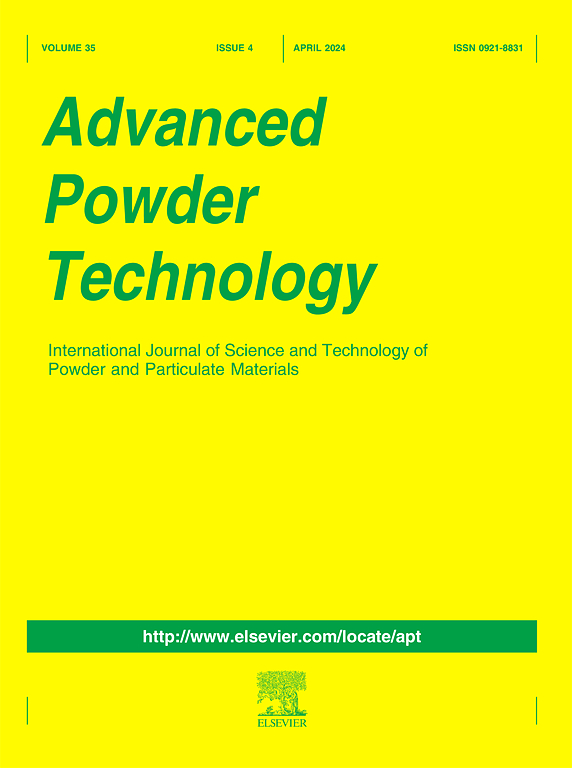Enhanced photocatalytic and antimicrobial properties of titanium doped tin dioxide quantum dots for industrial wastewater treatment
IF 4.2
2区 工程技术
Q2 ENGINEERING, CHEMICAL
引用次数: 0
Abstract
Pure SnO2 quantum dots (SnQ) and Ti-doped SnO2 quantum dots (SnQT) were synthesized via a facile one-step hydrothermal method (ESOSH) and characterized their structures and properties (XRD, FTIR, HRTEM, UV-DRS). The SnQ samples (thermally treated at 290 °C and 490 °C as SnQ1 and SnQ2, respectively) had crystalline sizes of ∼ 4 nm and ∼ 9 nm, serving as baseline materials, while titanium incorporation (Sn0.97Ti0.03O2 and Sn0.93Ti0.07O2 for SnQT1 and SnQT2) modulated the SnO2 lattice without introducing secondary phases. Ti doping substantially enhanced the optical and catalytic performance: SnQT1 exhibited a narrowed band gap (∼3.3 eV) and achieved the highest photocatalytic activity, degrading a model organic dye under simulated sunlight at a rate significantly faster than both the undoped SnQ and the higher-doped SnQT2 catalysts. SnQT1′s dye degradation rate constant was roughly three times that of SnQT2, highlighting the improved charge-carrier separation and extended light absorption due to Ti dopingfile-dhfkdtnsslcarpbj5mucvs. SnQT1 was also the most cost-efficient catalyst, with an estimated treatment cost of $25.67 per 1000 m3 of dye solution, outperforming the other compositions in economic analysis. Moreover, Ti-doped samples demonstrated superior antimicrobial efficacy: all catalysts inhibited Bacillus subtilis (Gram-positive) and Candida albicans (yeast), with SnQT1 showing the strongest antibacterial activity. This study underscores that titanium doping in SnO2 quantum dots yields doped quantum-dot photocatalysts with superior performance, providing valuable insights for designing high-efficiency, sustainable nanomaterials for wastewater treatment and disinfection applications.

二氧化钛掺杂量子点在工业废水处理中的光催化和抗菌性能
采用简单的一步水热法(ESOSH)合成了纯SnO2量子点(SnQ)和掺钛SnO2量子点(SnQT),并对其结构和性能进行了表征(XRD, FTIR, HRTEM, UV-DRS)。SnQ样品(分别在290°C和490°C热处理为SnQ1和SnQ2)的晶粒尺寸为~ 4 nm和~ 9 nm,作为基准材料,而钛的掺入(SnQT1和SnQT2的Sn0.97Ti0.03O2和Sn0.93Ti0.07O2)在不引入二次相的情况下调制了SnO2晶格。Ti掺杂大大提高了光学和催化性能:SnQT1表现出窄带隙(~ 3.3 eV),并实现了最高的光催化活性,在模拟阳光下降解模型有机染料的速度明显快于未掺杂的SnQ和高掺杂的SnQT2催化剂。SnQT1的染料降解速率常数大约是SnQT2的3倍,这表明由于Ti掺杂file-dhfkdtnsslcarpbj5mucvs, SnQT1的载流子分离得到了改善,光吸收得到了延长。SnQT1也是最具成本效益的催化剂,估计每1000立方米染料溶液的处理成本为25.67美元,在经济分析中优于其他组合物。此外,ti掺杂样品表现出优异的抗菌效果:所有催化剂都能抑制枯草芽孢杆菌(革兰氏阳性)和白色念珠菌(酵母),其中SnQT1的抗菌活性最强。该研究强调,在SnO2量子点中掺杂钛可以获得性能优越的掺杂量子点光催化剂,为设计用于废水处理和消毒的高效、可持续的纳米材料提供了有价值的见解。
本文章由计算机程序翻译,如有差异,请以英文原文为准。
求助全文
约1分钟内获得全文
求助全文
来源期刊

Advanced Powder Technology
工程技术-工程:化工
CiteScore
9.50
自引率
7.70%
发文量
424
审稿时长
55 days
期刊介绍:
The aim of Advanced Powder Technology is to meet the demand for an international journal that integrates all aspects of science and technology research on powder and particulate materials. The journal fulfills this purpose by publishing original research papers, rapid communications, reviews, and translated articles by prominent researchers worldwide.
The editorial work of Advanced Powder Technology, which was founded as the International Journal of the Society of Powder Technology, Japan, is now shared by distinguished board members, who operate in a unique framework designed to respond to the increasing global demand for articles on not only powder and particles, but also on various materials produced from them.
Advanced Powder Technology covers various areas, but a discussion of powder and particles is required in articles. Topics include: Production of powder and particulate materials in gases and liquids(nanoparticles, fine ceramics, pharmaceuticals, novel functional materials, etc.); Aerosol and colloidal processing; Powder and particle characterization; Dynamics and phenomena; Calculation and simulation (CFD, DEM, Monte Carlo method, population balance, etc.); Measurement and control of powder processes; Particle modification; Comminution; Powder handling and operations (storage, transport, granulation, separation, fluidization, etc.)
 求助内容:
求助内容: 应助结果提醒方式:
应助结果提醒方式:


